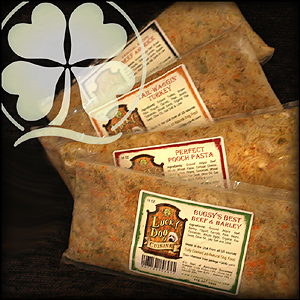 Cardiff's food of choice, Lucky Dog Cuisine, contains human grade, whole food ingredients. Delicious!
This article originally appeared on my blog for Flexcin International, Inc as Pet Food Labels: Good Ingredients- Proteins, Grains, Vegetables, Vitamins
Do you read the labels on your pet’s food and treats? You should! Understanding what is actually in your pet’s food is important to ensure your pet is receiving proper nutrition.
The FDA regulates all commercially available pet foods and treats. The label appearing on a product is required to list all ingredients and a guaranteed analysis that the product truly contains the ingredients stated – no more, no less.
This series will focus on helping you understand common ingredients in pet foods. There are Good, Bad, and Questionable Ingredients that may appear on any given label. In this article, let’s first look closely at Good Ingredients and tips for identifying them.
Proteins
Cardiff's food of choice, Lucky Dog Cuisine, contains human grade, whole food ingredients. Delicious!
This article originally appeared on my blog for Flexcin International, Inc as Pet Food Labels: Good Ingredients- Proteins, Grains, Vegetables, Vitamins
Do you read the labels on your pet’s food and treats? You should! Understanding what is actually in your pet’s food is important to ensure your pet is receiving proper nutrition.
The FDA regulates all commercially available pet foods and treats. The label appearing on a product is required to list all ingredients and a guaranteed analysis that the product truly contains the ingredients stated – no more, no less.
This series will focus on helping you understand common ingredients in pet foods. There are Good, Bad, and Questionable Ingredients that may appear on any given label. In this article, let’s first look closely at Good Ingredients and tips for identifying them.
Proteins
- Focus on feeding whole food based muscle meat protein instead of fractionated counterparts like “meals” and “by-products”.
- I recommend beef, chicken, fish, lamb, pork, rabbit, turkey, and other animal proteins such as heart and liver.
- Legumes, such as beans (black, kidney, red, white, etc), lentils, and peas also provide quality vegetarian sources of protein, fiber, vitamins, and minerals.
- Grains provide carbohydrates, protein, fiber, and other nutrients like prebiotics, which are substrates on which pro-biotic bacteria grow.
- I recommend barley, brown rice, corn, millet, quinoa, rice, and spelt.
- Find foods that list whole vegetables instead of hydrolyzed, meal, or starch versions.
- Beet, cauliflower, carrot, eggplant, potato, and spinach provide a healthy source of fiber, phytonutrients, and antioxidants.
- Dried and fresh fruits can also be a part of your pet’s food or added to its diet. Choose richly pigmented fresh fruits like blueberry, cantaloupe, cherry, raspberry, strawberry, and watermelon.
- Avoid grapes and raisins – they contain an unknown toxin that affects dogs’ kidneys. Also avoid dried fruits that contain added sugar and preservatives like sulfur dioxide.
- Fat is an important part of any diet because it provides the building blocks of muscle and nerve tissue. Pet foods may contain animal and/or plant based fats.
- Animal fat often comes from the rendering process and is likely to contain toxins (heavy metals, carcinogens, etc). For this reason, I recommend fats from other sources.
- Vegetable fats come from many parts of the plant, including fruit (like avocado, olive, etc), kernel, nut, or seed. Extra virgin, cold pressed olive oil and ground flax seed meal (good ‘meal’) are great vegetarian sources of healthy, polyunsaturated fat and omega fatty acids.
- Both vitamins and minerals are added to commercially available pet foods to suffice nutritional requirements per industry standard. These are typically synthetic forms that may not be efficiently absorbed as a result of improper binding with receptors inside the digestive tract.
